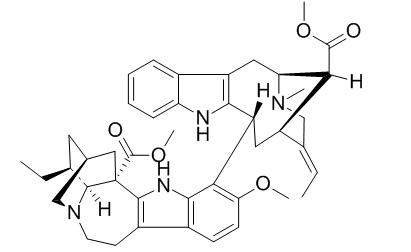Conodurine
Conodurine shows leishmanicidal and antibacterial activities, it shows inhibition activity for acetyl (AChE) and butyrylcholinesterase (BuChE).
Inquire / Order:
manager@chemfaces.com
Technical Inquiries:
service@chemfaces.com
Tel:
+86-27-84237783
Fax:
+86-27-84254680
Address:
1 Building, No. 83, CheCheng Rd., Wuhan Economic and Technological Development Zone, Wuhan, Hubei 430056, PRC
Providing storage is as stated on the product vial and the vial is kept tightly sealed, the product can be stored for up to
24 months(2-8C).
Wherever possible, you should prepare and use solutions on the same day. However, if you need to make up stock solutions in advance, we recommend that you store the solution as aliquots in tightly sealed vials at -20C. Generally, these will be useable for up to two weeks. Before use, and prior to opening the vial we recommend that you allow your product to equilibrate to room temperature for at least 1 hour.
Need more advice on solubility, usage and handling? Please email to: service@chemfaces.com
The packaging of the product may have turned upside down during transportation, resulting in the natural compounds adhering to the neck or cap of the vial. take the vial out of its packaging and gently shake to let the compounds fall to the bottom of the vial. for liquid products, centrifuge at 200-500 RPM to gather the liquid at the bottom of the vial. try to avoid loss or contamination during handling.
Anticancer Agents Med Chem.2023, 23(10):1204-1210.
J Mol Histol.2019, 50(4):343-354
Front Plant Sci.2022, 13: 905275.
Sci Rep.2019, 9:12132
SCOPUS.2020, 836-847.
J Cell Physiol.2021, 236(3):1950-1966.
Plants (Basel).2020, 9(11):1535.
Journal of Herbal Medicine2024, 48:100950
Microchemical Journal2022, 182: 107874.
Indian Journal of Science and Technology2023, 16(SP1):48-56.
Related and Featured Products
Planta Med. 1994 Oct;60(5):455-9.
Isolation of bis-indole alkaloids with antileishmanial and antibacterial activities from Peschiera van heurkii (syn. Tabernaemontana van heurkii).[Pubmed:
7997477]
METHODS AND RESULTS:
Extracts from leaves and stem bark of Peschiera van heurkii (Muell. Arg.) L. Allorge (syn. Tabernaemontana van heurkii Muell. Arg., Apocynaceae) have been assayed for antileishmanial and antibacterial activities. The activities were concentrated in the alkaloid fractions which yielded 20 indole and bisindole alkaloids. The strongest leishmanicidal and antibacterial activities were observed with the dimeric alkaloids Conodurine (1), N-demethylConodurine (= gabunine) (2), and conoduramine (3).
CONCLUSIONS:
Weak toxicity towards macrophage host cells and strong activity against the intracellular amastigote form of Leishmania were observed for compounds 1 and 2. In vivo, 1 was less active than glucantime (= N-methylglucamine antimonate), the drug of reference, while 2 was devoid of activity at 100 mg/kg.
An Acad Bras Cienc. 2008 Sep;80(3):419-26.
Two fast screening methods (GC-MS and TLC-ChEI assay) for rapid evaluation of potential anticholinesterasic indole alkaloids in complex mixtures.[Pubmed:
18797794]
METHODS AND RESULTS:
In this work two fast screening techniques were combined in order to easily identify novel cholinesterase inhibitors (ChEI). Gas chromatography-mass spectrometry (GC-MS) of the less polar alkaloidic fractions obtained from the acid-base extraction of the stalk of T. laeta revealed thirteen monoindole alkaloids, four of them confirmed by co-injection with previously isolated alkaloids. The others were tentatively identified by mass fragmentation analysis. By gas chromatography with flame ionization detection (GC-FID) and using isatin as internal standard, affinisine and voachalotine were determined as major compounds. These fractions and fourteen previously isolated alkaloids, obtained from root bark of T. laeta and T. hystrix were investigated for acetyl (AChE) and butyrylcholinesterase (BuChE) inhibitory activities by the modified Ellman's method in thin layer chromatography(TLC-ChEI).
CONCLUSIONS:
Results showed selective inhibition of the alkaloids heyneanine and Nb-methylvoachalotine for BuChE, and 19-epi-isovoacristine for AChE, whereas olivacine, affinisine, ibogamine, affinine, Conodurine and hystrixnine inhibited both enzymes. In addition to confirming that monoterpenoid indole alkaloids can be novel therapeutic agents for AD, this is the first report of the ChEI activity of olivacine, a pyridocarbazole alkaloid.
Phytochemistry. 2003 Jul;63(5):625-9.
Conodurine, conoduramine, and ervahanine derivatives from Tabernaemontana corymbosa.[Pubmed:
12809725]
METHODS AND RESULTS:
Four bisindole alkaloids, viz., 19'(S)-hydroxyConodurine, conodurinine, 19'(S)-hydroxyconoduramine, and 19'(S)-hydroxyervahanine A, in addition to Conodurine and ervahanine A, were obtained from the leaf and stem-bark extracts of Tabernaemontana corymbosa.
CONCLUSIONS:
The structures of the new alkaloids were determined using NMR and MS analysis.
3,3',4',5,6,7,8-heptamethoxyflavone
Catalog No: CFN95021
CAS No: 1178-24-1
Price: $268/10mg
Fargesol
Catalog No: CFN95027
CAS No: 128855-64-1
Price: $318/20mg
Quercetin 3-O-beta-(6''-p-coumaroyl)glucopyranosyl(1->2)-alpha-L-rhamnopyranoside
Catalog No: CFN95088
CAS No: 143061-65-8
Price: $338/10mg
1,7-Diphenyl-5-hydroxy-4,6-hepten-3-one
Catalog No: CFN95171
CAS No: 87095-77-0
Price: $318/10mg
(3R,5S,E)-1,7-Diphenylhept-1-ene-3,5-diol
Catalog No: CFN95227
CAS No: 232261-31-3
Price: $318/5mg
Batatasin V
Catalog No: CFN95320
CAS No: 65817-45-0
Price: $318/5mg
Dehydrodicatechin A
Catalog No: CFN95451
CAS No: 36048-23-4
Price: $318/5mg
Maingayone B
Catalog No: CFN95483
CAS No: 1071223-57-8
Price: $318/20mg
Taxezopidine H
Catalog No: CFN95562
CAS No: 205440-23-9
Price: $318/5mg
Methyl ganoderate E
Catalog No: CFN95582
CAS No: 98718-43-5
Price: $413/5mg



